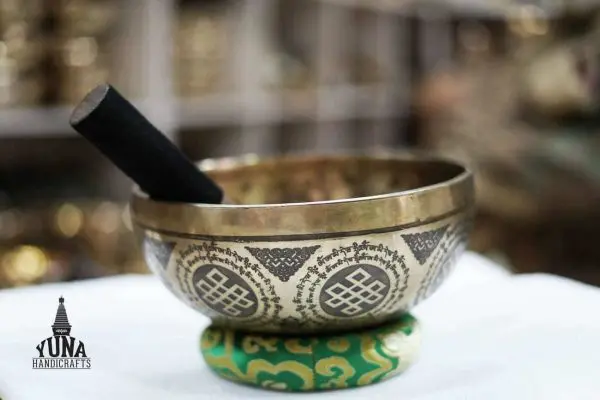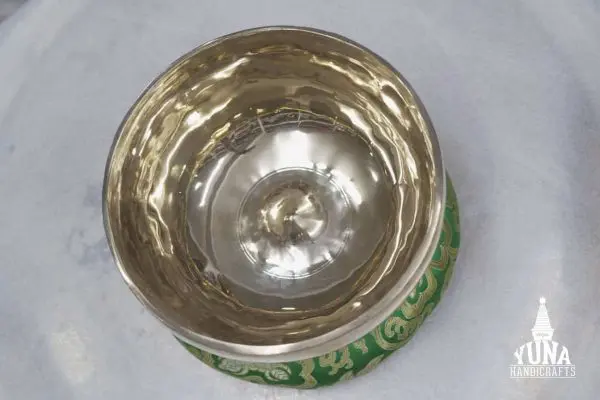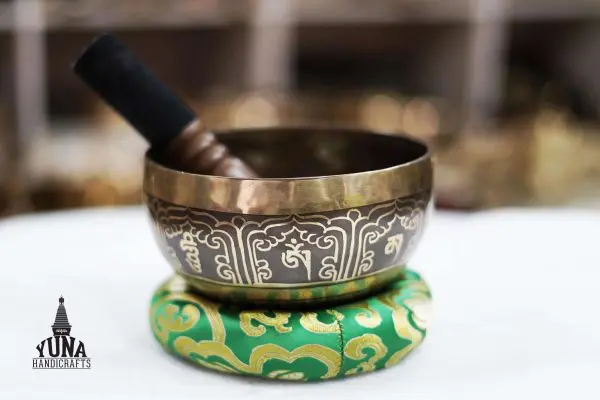Blog
Tibetan Sound Bowls
![]()
Table of Contents
Tibetan Sound Bowls: Discover Their History, Healing Benefits, and Holistic Applications
Intro: Tibetan Sound Bowls
Tibetan sound bowls, also called singing bowls, are ancient tools revered for their soothing sounds and healing vibrations. Rooted in the rich spiritual practices of Nepal and Tibet, these bowls are not only instruments of sound but of harmony, balance, and meditation. Yuna Handicrafts offers a carefully curated selection of these bowls, each handcrafted with care and tradition to bring you the authentic experience of Tibetan sound healing. In this comprehensive guide, we will delve into every aspect of Tibetan sound bowls: their historical significance, how they are crafted, the physical and mental benefits they offer, and ways to incorporate them into your wellness practices.

A Brief History of Tibetan Sound Bowls: Ancient Origins and Modern Revival
Tibetan sound bowls have a history that spans over a thousand years, with their origins believed to lie within ancient Buddhist practices in the Himalayan regions. They were initially used by monks and spiritual practitioners to enhance meditation, facilitate healing, and promote a sense of calm. Traditional Tibetan sound bowls are said to be made from an alloy of seven metals, each representing a planet in our solar system. This composition imbues the bowls with powerful, harmonious frequencies believed to create a deep connection between earthly and cosmic energies.
Over time, the use of Tibetan sound bowls expanded beyond religious settings, gaining popularity as a tool for personal meditation, healing, and spiritual growth. Today, Tibetan sound bowls are widely recognized for their therapeutic properties, allowing people across the globe to experience the calming and restorative power of sound healing. Yuna Handicrafts offers a variety of Tibetan sound bowls, preserving the traditional crafting techniques and high-quality materials to ensure each bowl resonates with authenticity and intention.
How Tibetan Sound Bowls Are Made: The Art of Crafting Sound and Vibration
Creating a Tibetan sound bowl is a meticulous process, combining traditional craftsmanship with spiritual intention. Skilled artisans in Nepal and Tibet handcraft each bowl from an alloy of metals, which often includes copper, tin, iron, and occasionally silver or gold. The choice of metals contributes to the bowl’s unique sound quality and energetic properties, making each bowl one-of-a-kind.
The crafting process begins with melting the metals together, then hammering the material into shape. Traditionally, Tibetan sound bowls are hand-hammered, with each stroke of the hammer creating a distinct texture and sound profile. After the bowl has been shaped, it is polished and tuned to produce the desired tone and frequency. Some bowls are etched with intricate designs or spiritual symbols, such as the “Om Mani Padme Hum” mantra or mandalas, which are thought to enhance the bowl’s vibrational qualities.
One special type of Tibetan sound bowl is the “Full Moon Bowl,” which is crafted under the full moon’s light. This process is believed to enhance the bowl’s energetic properties, making it particularly powerful for spiritual practices. At Yuna Handicrafts, we offer a range of Tibetan sound bowls, from traditional hand-hammered designs to those infused with specific intentions, ensuring a selection that meets diverse needs and preferences.
Also visit:-
The Healing Benefits of Tibetan Sound Bowls
Tibetan sound bowls are known for their profound impact on mental, physical, and spiritual well-being. Sound healing, as practiced with these bowls, uses sound vibrations to promote relaxation, reduce stress, and restore balance to the body and mind. Let’s explore the benefits of Tibetan sound bowls in more depth:
- Stress Relief and Relaxation
The soothing sound vibrations of a Tibetan sound bowl help quiet the mind and induce a state of deep relaxation. The repetitive tones and sustained frequencies make it easier for the mind to let go of worries, focusing instead on the present moment. This makes Tibetan sound bowls an ideal tool for those struggling with stress, anxiety, or mental fatigue. - Enhanced Focus and Mental Clarity
The gentle tones of a Tibetan sound bowl can help improve concentration and mental clarity. By creating a calming atmosphere, the bowl’s sound allows you to center your thoughts and be fully present. Many users find that Tibetan sound bowls improve their focus, making them an excellent addition to meditation practices or any activity requiring mental clarity. - Physical Healing and Pain Relief
Tibetan sound bowls create sound waves that penetrate deeply into the body, stimulating cells, tissues, and organs. Some users report that the vibrations help reduce pain, improve blood circulation, and boost the body’s natural healing processes. While sound healing is not a substitute for medical treatment, many people find it complements their wellness routine by promoting relaxation and encouraging the body’s self-healing abilities. - Emotional Balance and Chakra Healing
In spiritual practices, Tibetan sound bowls are often used to balance the chakras, or energy centers, of the body. Each bowl can be tuned to a specific frequency that corresponds to a particular chakra, helping to release blockages and promote emotional harmony. By balancing these energy centers, Tibetan sound bowls can help you achieve a sense of peace, balance, and spiritual alignment. - Improved Sleep Quality
For those struggling with insomnia or poor sleep quality, Tibetan sound bowls can be a helpful remedy. The calming vibrations produced by the bowl encourage relaxation, slowing down the mind and easing the body into a state of restfulness. Incorporating Tibetan sound bowls into a nighttime ritual can help improve sleep quality and promote a more restful night’s sleep.

Different Types of Tibetan Sound Bowls
Tibetan sound bowls come in various types, each with unique characteristics and uses. Here are some popular varieties available at Yuna Handicrafts:
- Hand-Hammered Bowls
These bowls are created using traditional hand-hammering techniques, resulting in a distinctive, rustic appearance and rich, layered tones. Hand-hammered bowls are highly valued for their craftsmanship and unique sound quality, making them an ideal choice for those looking to experience the authenticity of traditional sound healing. - Machine-Made Bowls
Machine-made Tibetan sound bowls are crafted using modern manufacturing techniques, resulting in a smoother, more polished appearance. While they may lack the rustic charm of hand-hammered bowls, machine-made bowls offer precise tones and consistent frequencies, making them suitable for focused meditation and sound healing practices. - Full Moon Bowls
These special bowls are crafted under the full moon’s light, believed to enhance their vibrational and energetic properties. Full Moon Bowls are often chosen for spiritual rituals and meditation practices, as they are thought to carry a heightened sense of calm and intention. - Crystal Singing Bowls
Although not traditional Tibetan sound bowls, crystal singing bowls are popular in sound healing for their clear, resonant tones. Made from quartz crystal, these bowls produce a pure sound that is often used to balance chakras and promote relaxation. Crystal singing bowls are especially valued for their high vibration and strong resonance, making them a powerful tool for those seeking deep meditative states.
Also visit:-
How to Use a Tibetan Sound Bowl for Meditation and Healing
Using a Tibetan sound bowl is a simple yet profound experience. Here are some basic steps and techniques to help you get started with your sound healing journey:
- Choose the Right Environment
Find a quiet, peaceful space where you can fully immerse yourself in the sound. A calm environment is essential for maximizing the bowl’s benefits and ensuring an undistracted experience. - Holding and Striking the Bowl
Place the bowl in the palm of your non-dominant hand and hold the mallet in your dominant hand. Gently strike the rim or side of the bowl to create an initial sound. This first sound will set the tone for your practice, helping you focus on the present moment. - Creating a “Singing” Sound
After striking the bowl, run the mallet around the rim in a circular motion. Gradually increase the pressure until the bowl starts to “sing.” Experiment with the speed and pressure to find a sound that resonates with you. This singing sound creates a continuous vibration that promotes relaxation and mental clarity. - Chakra Healing with Tibetan Sound Bowls
If you’re using the bowl for chakra healing, place it near the energy center you wish to balance. Each chakra has a specific frequency, so using a bowl tuned to that frequency will enhance the effect. As you play the bowl, visualize energy flowing freely through the chakra, promoting alignment and harmony.
Caring for Your Tibetan Sound Bowl: Maintenance and Storage Tips
To ensure your Tibetan sound bowl remains in pristine condition, it’s important to care for it properly. Here are some essential maintenance tips:
- Regular Cleaning
Clean your sound bowl regularly with a soft, dry cloth to remove dust and fingerprints. Avoid using abrasive materials or harsh chemicals, as these can damage the bowl’s finish. If needed, use a damp cloth with mild soap and dry immediately. - Energy Cleansing
Tibetan sound bowls absorb energy, so it’s essential to cleanse them periodically. Place your bowl under the moonlight, use a sage smudge stick, or strike the bowl to release any stagnant or negative energy. This process helps keep the bowl’s vibrations pure, ensuring it remains energetically clean. - Proper Storage
Store your Tibetan sound bowl in a safe place, ideally on a padded cushion or cloth to prevent scratches. Avoid exposure to direct sunlight or extreme temperatures, as these can affect the bowl’s sound quality and appearance.
Also visit:-
Tibetan Sound Bowls in Modern Wellness Practices
Today, Tibetan sound bowls have become a staple in holistic wellness practices worldwide. Sound baths, yoga studios, and meditation centers frequently incorporate Tibetan sound bowls to enhance relaxation and promote a deeper connection with oneself. Whether you’re an experienced practitioner or new to sound healing, a Tibetan sound bowl offers a powerful, grounding tool for wellness and personal growth.
With Yuna Handicrafts’ collection of Tibetan sound bowls, you can begin or deepen your journey into sound healing, meditation, and holistic wellness. Each bowl in our collection is crafted with precision and reverence for tradition, ensuring a quality sound and spiritual experience for every user.
Embrace the calming, healing vibrations of Tibetan sound bowls with Yuna Handicrafts and elevate your meditation or wellness practice to new levels of tranquility, balance, and spiritual connection. Whether you’re looking to relieve stress, improve mental clarity, or promote physical healing, Tibetan sound bowls offer a timeless, effective solution to foster overall well-being.

Faq’s on Tibetan Sound Bowls:-
1. What is a Tibetan sound bowl?
A Tibetan sound bowl, also known as a singing bowl, is a type of standing bell that produces calming, meditative sounds when struck or circled with a mallet. It has roots in Tibetan and Himalayan spiritual practices and is often used in meditation, sound therapy, and holistic healing.
2. How does a Tibetan sound bowl work?
Tibetan sound bowls create sound vibrations when their edges are struck or rubbed with a mallet. These vibrations produce calming tones and frequencies, which can help induce relaxation, focus, and healing.
3. What are the benefits of using a Tibetan sound bowl?
Tibetan sound bowls can help reduce stress, improve focus, relieve pain, promote emotional balance, and enhance meditation. They’re also known for promoting chakra alignment and improving sleep quality.
4. How do I use a Tibetan sound bowl?
To use a Tibetan sound bowl, hold it in one hand, and with the mallet in the other hand, strike the edge or rim. For a continuous sound, run the mallet around the rim in a circular motion, applying steady pressure.
5. Are Tibetan sound bowl suitable for beginners?
Yes, Tibetan sound bowl are easy to use and suitable for beginners. Their simple yet powerful vibrations make them accessible to anyone interested in meditation, sound healing, or relaxation.
6. What types of Tibetan sound bowl are available at Yuna Handicrafts?
Yuna Handicrafts offers a variety of Tibetan sound bowls, including hand-hammered bowls, machine-made bowls, crystal bowls, and Full Moon bowls. Each type has unique characteristics to meet different preferences and needs.
7. What is a Full Moon Tibetan sound bowl?
A Full Moon bowl is a special type of Tibetan sound bowl crafted under the full moon. This process is believed to enhance its energetic and vibrational qualities, making it a popular choice for spiritual practices.
8. What size Tibetan sound bowl should I choose?
The size of the bowl affects the tone and depth of sound. Smaller bowls produce higher-pitched sounds, while larger bowls create deeper, resonant tones. Choose based on your sound preference and intended use.
9. How are Tibetan sound bowl made?
Traditional Tibetan sound bowl are handmade, often using an alloy of seven metals representing different planets. The bowl is heated, hammered, and shaped by skilled artisans, resulting in unique tones and designs.
10. Can Tibetan sound bowl help with chakra healing?
Yes, Tibetan sound bowl are often used for chakra healing. Each chakra corresponds to a specific frequency, and playing the bowl near a chakra is believed to balance and align its energy.
11. What metals are used to make a Tibetan sound bowl?
Traditional Tibetan sound bowl are made from a blend of seven metals, including gold, silver, copper, iron, mercury, tin, and lead. This combination is believed to create harmonious vibrations that connect with cosmic energies.
12. How do I care for my Tibetan sound bowl?
Clean your Tibetan sound bowl with a soft, dry cloth to remove dust. Avoid harsh chemicals and store it in a safe place away from direct sunlight to preserve its appearance and sound quality.
13. Can Tibetan sound bowl improve sleep?
Yes, Tibetan sound bowl can promote better sleep by reducing stress and calming the mind. Incorporating a sound bowl into a nighttime routine can help ease insomnia and encourage restful sleep.
14. Are there different techniques for playing a Tibetan sound bowl?
Yes, you can strike the bowl’s edge for a single sound or rub the mallet around the rim to produce a continuous, meditative “singing” sound. Experimenting with pressure and speed can create different effects.
15. How do Tibetan sound bowl enhance meditation?
Tibetan sound bowl create frequencies that promote relaxation and mental clarity, helping the mind stay focused and grounded during meditation. Their sound can also guide breathing and deepen mindfulness.
16. Can Tibetan sound bowl relieve physical pain?
While Tibetan sound bowl are not a replacement for medical treatment, some people find that the vibrations help reduce pain by promoting relaxation and improving circulation. They’re commonly used in holistic wellness practices.
17. What is the significance of the designs on Tibetan sound bowl?
Many Tibetan sound bowl feature spiritual symbols, mantras, or mandalas. These designs are believed to enhance the bowl’s energy and intention, adding spiritual meaning to sound healing practices.
18. Are there specific mallets for Tibetan sound bowl?
Yes, mallets can be made of wood, leather, or felt. The material affects the sound produced. For example, wooden mallets produce a sharp, clear tone, while felted mallets create softer, deeper sounds.
19. Can I use a Tibetan sound bowl outdoors?
Yes, Tibetan sound bowl can be used outdoors in calm environments. However, be mindful of weather conditions and surfaces, as extreme temperatures and rough handling can affect the bowl’s quality and sound.
20. What is the difference between a Tibetan sound bowl and a crystal singing bowl?
Tibetan sound bowl are traditionally made from metal alloys, while crystal singing bowls are made from quartz crystal. Crystal bowls generally produce a higher pitch and are often used specifically for chakra healing.
21. How can I tell if a Tibetan sound bowl is authentic?
Authentic Tibetan sound bowl are typically handmade and have slight imperfections or unique markings from the hammering process. They produce a rich, layered sound. Yuna Handicrafts offers authentic, handcrafted sound bowls.
22. Are Tibetan sound bowl used in yoga?
Yes, Tibetan sound bowl are often used in yoga to enhance relaxation and deepen the meditative aspect of the practice. They’re particularly beneficial in yin or restorative yoga sessions.
23. How often should I clean my Tibetan sound bowl?
You can wipe down your Tibetan sound bowl after each use with a soft cloth to remove fingerprints or dust. A more thorough cleaning may be done once every few months, depending on usage.
24. Can children use Tibetan sound bowl?
Yes, Tibetan sound bowls are safe for children to use under supervision. They can help introduce mindfulness and relaxation techniques to children, making them a great tool for family meditation.
25. How can I incorporate a Tibetan sound bowl into my daily routine?
Incorporate a Tibetan sound bowl by using it during morning meditation, before sleep, or as a way to clear negative energy. A few minutes of playing the bowl each day can help maintain a calm and balanced mindset.
Contact Us:-
ADDRESS
Loktantrik Chowk, Nakhipot-14, Lalitpur, Nepal
CONTACT HOURS
Sunday to Saturday 24/7
E-MAIL yuna.handicrafts@gmail.com
PHONE +977 9851-131344 (WhatsApp)


